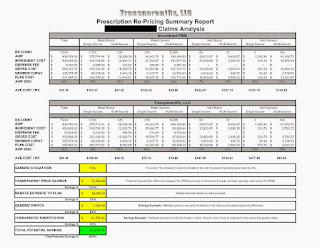Tyrone’s comment: Similarly, I’m astonished that I continue to come across third-party payers, such as self-funded employers, who don’t know how much they pay PBMs and/or TPAs for managing the pharmacy benefit. This is far different than net plan costs as the PBMs take is hidden in the total pharmacy spend.
 |
| Price comparison: non-fiduciary PBM (incumbent) vs. fiduciary PBM |
At the big picture level, PwC has pointed out that more than half of healthcare spending adds no value (PDF). At a ground level, we see employers spending 55% less on health benefits with a benefits package better than 99% of the workforce. In other words, the best way to slash healthcare costs is to improve benefits.
Suddenly, CEOs (and CFOs) recognize the annual health benefits Kabuki dance is jeopardizing the viability of their business. CEOs are running the numbers and recognize that they are a benefits renewal or two from being put out of business and finally scrutinize healthcare spending like they do any other input.
I recently spoke with John Torinus (Chairman of Serigraph and author of the book, The Company That Solved Healthcare). Torinus described how manufacturers are managing costs two or three points to the right of the decimal point. Meanwhile they were seeing 100% or more variance in healthcare costs with no correlation to value.
Tyrone’s comment: Unlike manufacturers, most self-funded employers are managing pharmacy costs six or seven points to the left of the decimal point! There is a simple litmus test to help determine whether or not my theory is true. Ask yourself, “what is our PBM’s and/or TPA’s take for providing pharmacy benefit management services to our organization?” If you have no clue you are overpaying unless of course your PBM entered into a fiduciary agreement with you. Otherwise, you’d be wise to learn how to manage pharmacy costs two or three points to the right of the decimal point.
If fixes already exist, why isn’t everyone using them?
Healthcare’s redemption is a classic example of solutions hidden in plain site. Noted business consultant and author Ric Merrifield summed this up during message testing: “The Big Short, and Moneyball, had one major theme in common–in the face of a mountain of evidence, the evidence was ignored… Wall Street and regulators didn’t downgrade the credit ratings of the mortgage backed securities even when the mountain of evidence was presented to them. So why should we expect healthcare to be any different? Healthcare is in the same place at the moment. The healthcare mess in many ways is happening in broad daylight.”
